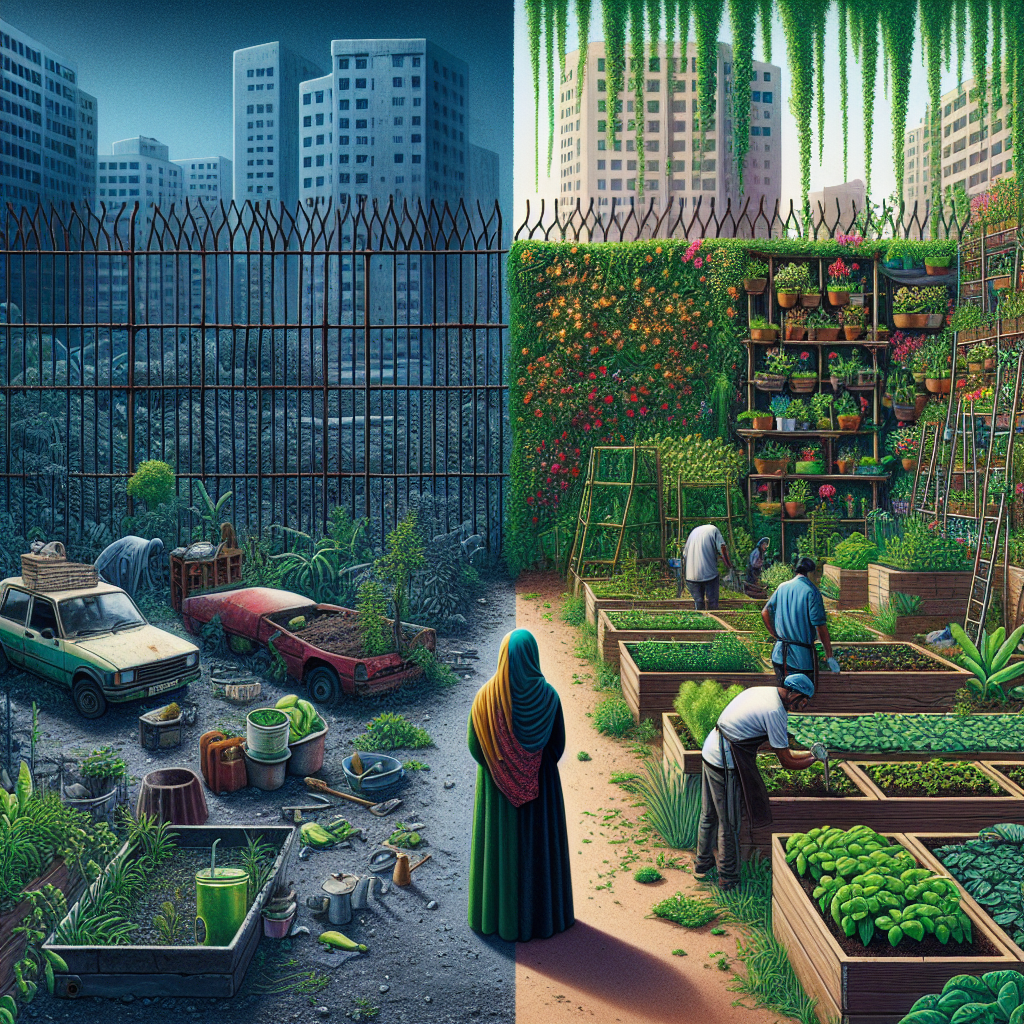
Imagine a cityscape dotted with lush green gardens and vibrant farms, thriving in the midst of once desolate vacant lots and abandoned spaces. It may seem like a distant dream, but the concept of transforming these neglected areas into urban farming spaces is gaining momentum. By harnessing the power of urban agriculture, we have the potential to not only create a sustainable food source, but also revitalize communities and foster a deeper connection with the environment. In this article, we will explore the transformative possibilities of repurposing these neglected spaces and uncover the incredible benefits they can bring to our cities.
Benefits of Transforming Vacant Lots into Urban Farming Spaces
Improved Food Security
Transforming vacant lots into urban farming spaces can have a significant impact on improving food security in communities. By utilizing these spaces for farming, fresh and nutritious produce can be grown locally, reducing reliance on imported or shipped-in food. This not only ensures a steady supply of healthy food but also reduces the risk of food shortages or price fluctuations.
Enhanced Community Engagement
Urban farming spaces provide a platform for increased community engagement and social interaction. They bring people together through shared interests in agriculture, gardening, and sustainable living. These spaces can serve as community hubs, where residents can collaborate, share knowledge, and establish connections. Through collective farming activities, such as community gardens, residents can develop a sense of ownership and pride in their neighborhoods.
Environmental Sustainability
Converting vacant lots into urban farming spaces contributes to environmental sustainability in multiple ways. Firstly, it reduces urban sprawl and promotes the reuse of existing land resources, minimizing the need for further land clearance. Urban farming also helps mitigate the urban heat island effect by increasing vegetation cover and reducing surface temperatures. Additionally, these spaces can improve air and water quality through vegetation absorption and filtration.
Economic Opportunities
Transforming vacant lots into urban farming spaces creates economic opportunities for individuals and communities. Local residents can generate income by selling their produce to farmers’ markets, restaurants, or directly to consumers. Moreover, urban farming can stimulate entrepreneurship by encouraging the establishment of small businesses and agricultural cooperatives. By diversifying the local economy, these urban farming spaces can contribute to long-term economic growth and job creation.
Identifying Suitable Vacant Lots
Assessing Availability and Accessibility
To identify suitable vacant lots for urban farming, it is important to assess their availability and accessibility. Look for lots that are not currently in use or have been abandoned. Consider the proximity of the lot to residential areas, public transportation, and community facilities, to ensure that people can easily access the farming space. Availability and accessibility are key factors in increasing community participation and engagement.
Analyzing Soil Conditions
Soil analysis is crucial in determining the suitability of a vacant lot for farming. Conduct soil tests to evaluate its nutrient content, pH levels, and potential contaminants. Soil that is rich in organic matter and has proper drainage is ideal for agriculture. If the soil conditions are not favorable, techniques such as soil remediation or raised bed gardening can be employed to optimize productivity.
Considering Sunlight Exposure
Another important factor to consider is the sunlight exposure of the vacant lot. Ideally, urban farming spaces should receive ample sunlight throughout the day to support plant growth. Evaluate the amount of shade and the position of nearby buildings or trees that may obstruct sunlight. Areas with consistent sunlight exposure are more likely to yield better crop production.
Evaluating Legal and Regulatory Factors
Before initiating an urban farming project, it is essential to evaluate legal and regulatory factors that may impact the use of vacant lots for agriculture. Some areas may have zoning restrictions or regulations pertaining to land use. Consult with local government authorities or planning departments to ensure compliance with existing regulations. This evaluation will help avoid potential legal challenges and ensure a smooth implementation process.

Design and Planning Considerations for Urban Farming Spaces
Optimizing Space Efficiency
Designing urban farming spaces to maximize space efficiency is critical, especially in areas with limited land availability. Utilize vertical gardening techniques, such as trellises or hanging baskets, to grow crops vertically instead of horizontally. Integrate raised beds and container gardening to effectively utilize small areas. By optimizing space efficiency, more produce can be cultivated, ensuring a higher yield in limited spaces.
Implementing Irrigation Systems
Establishing efficient irrigation systems is vital for the success of urban farming spaces. Consider installing drip irrigation or micro-sprinkler systems that deliver water directly to plant roots, minimizing water usage and reducing the risk of water loss through evaporation. Automated irrigation systems with timers can also ensure regular and consistent watering, even during periods when caretakers may be unavailable.
Incorporating Sustainable Farming Practices
It is important to prioritize sustainable farming practices in urban farming spaces. Implement composting systems to recycle organic waste and enrich the soil. Introduce integrated pest management techniques that minimize the use of chemical pesticides. Utilize organic and locally sourced fertilizers to promote soil health and reduce environmental impacts. By incorporating sustainable practices, urban farming spaces can contribute to ecosystem resilience and promote long-term environmental sustainability.
Creating Diverse and Productive Zones
Design urban farming spaces to include diverse and productive zones. Create areas for growing different types of crops, including fruits, vegetables, herbs, and flowers. Incorporate spaces for pollinator-friendly plants to support the health of bees and other essential pollinators. Integrate educational areas where residents can learn about sustainable farming practices, participate in workshops, and cultivate their gardening skills. By offering diverse and productive zones, urban farming spaces can cater to various community needs and interests.
Infrastructure and Resource Requirements
Fencing and Security Measures
To protect urban farming spaces from theft, vandalism, or damage by animals, appropriate fencing and security measures should be put in place. Install sturdy fencing materials that are tall enough to deter intruders. Use lockable gates to control access. Consider installing security cameras or alarm systems to monitor and protect the farming areas. Adequate security measures will safeguard the investment and maintain a safe environment for plants and farm activities.
Water Supply and Storage
Access to a reliable water supply is essential for urban farming spaces. Evaluate the availability of water sources, such as municipal water connections or nearby water bodies. If water supply is limited, explore rainwater harvesting or wastewater reuse systems. Install water storage tanks or reservoirs to ensure a constant supply of water, especially during dry periods. Efficient water management and conservation practices are crucial to sustain urban farming operations.
Seed and Compost Procurement
Procuring high-quality seeds and compost is an important consideration for urban farming spaces. Seek out certified organic seed suppliers or local seed banks to access a wide variety of suitable seeds. Establish composting systems on-site, utilizing food scraps and plant waste to produce nutrient-rich compost. Engage with local farmers or gardening communities to exchange knowledge and resources related to seed and compost procurement.
Equipment and Tools
Having the necessary equipment and tools is vital for successful urban farming. Determine the specific needs based on the type of farming activities planned. Basic tools such as shovels, rakes, and watering cans are essential. Consider acquiring specialized equipment such as small tillers or greenhouse structures, depending on the scale and complexity of the farming operation. Regular maintenance and upkeep of equipment ensure their longevity and efficient operation.

Engaging the Community
Raising Awareness and Support
Engaging the community starts with raising awareness and garnering support for urban farming initiatives. Conduct informational campaigns through local media outlets, social media platforms, and community events. Share success stories and benefits of urban farming to inspire and motivate residents to get involved. Highlight the potential positive impacts on food security, community bonding, and environmental sustainability. Utilize signage or banners at the farming spaces to attract attention and generate curiosity.
Collaborating with Local Organizations
Collaborating with local organizations can amplify the impact of urban farming spaces. Reach out to nonprofit organizations, community groups, or schools that promote sustainable living, agriculture, or nutrition education. By working together, resources and expertise can be shared, and joint initiatives can be established. Collaboration can also help attract funding and support from a wider network of stakeholders, fostering a stronger sense of community ownership.
Involving Residents in Farming Activities
Encouraging residents to actively participate in farming activities fosters a sense of connection and ownership of the urban farming spaces. Organize community workdays or volunteer opportunities, where individuals can contribute their time and labor to farm maintenance or harvesting. Offer gardening workshops or training programs to enhance residents’ knowledge and skills. By involving residents, not only do urban farming spaces thrive, but a stronger sense of community is nurtured.
Educating and Training Programs
Implementing educational and training programs is crucial to equip residents with the necessary knowledge and skills for successful urban farming. Offer workshops on sustainable farming practices, crop rotation, composting, or pest management. Organize cooking classes or nutrition workshops that highlight the benefits of consuming locally grown produce. Provide opportunities for residents to learn about the entire farming process, from seed to table. Educational programs empower individuals to become active participants in the local food system.
Challenges and Potential Solutions
Lack of Financial Resources
One of the common challenges in transforming vacant lots into urban farming spaces is limited financial resources. Securing funding for land acquisition, infrastructure development, and ongoing operations can be daunting. Seek grants or financial support from government agencies, foundations, or corporate sponsorships. Explore crowdfunding platforms or engage in community fundraising initiatives. Building partnerships with local businesses or establishing a community-supported agriculture (CSA) model can also generate a sustainable source of income.
Land Ownership and Acquisition
Navigating land ownership and acquisition processes can be complex. Identify vacant lots that are publicly owned or underutilized private properties. Engage with local government or land banks to explore land leasing or temporary use agreements. Collaborate with property owners or real estate developers to negotiate land access for agricultural purposes. Establishing land trusts or community land ownership models can provide long-term stability and ensure the continuity of urban farming spaces.
Community Opposition or Concerns
Not all community members may initially support the idea of transforming vacant lots into urban farming spaces. Address concerns and opposition by providing factual information about the benefits of urban farming. Conduct public meetings or forums to engage in open dialogue and address misconceptions. Invite skeptics to visit existing urban farming spaces to witness their positive impact firsthand. Collaborate with local universities or research institutions to conduct studies and evaluate the benefits and potential drawbacks.
Maintenance and Sustainability
Ensuring the long-term maintenance and sustainability of urban farming spaces can be challenging. Develop maintenance plans that include regular weeding, watering, and pest control. Mobilize volunteers or establish caretaker teams to share responsibilities and prevent burnout. Integrate educational programs to foster a culture of sustainable farming practices among residents. Continuously evaluate and adapt farming techniques to optimize productivity and minimize environmental impacts. Prioritize ongoing communication and engagement with the community to address concerns and sustain support.

Success Stories and Case Studies
The Growing Power Initiative in Milwaukee
The Growing Power initiative in Milwaukee, Wisconsin, is a prime example of how vacant lots can be transformed into thriving urban farming spaces. Started in 1993, Growing Power focuses on addressing issues of food justice and creating sustainable local food systems. Through aquaponics, vertical farming, and composting, they have successfully grown and distributed fresh produce to food-insecure communities. Growing Power’s model has inspired numerous other urban farming projects across the United States.
Urban Farming in Detroit
Detroit, Michigan, has witnessed a resurgence in urban farming, with numerous initiatives transforming vacant lots and abandoned buildings into productive agricultural spaces. Organizations like the Detroit Black Community Food Security Network and Earthworks Urban Farm have led the way in utilizing urban farming to address food insecurity and provide economic opportunities in underserved neighborhoods. These initiatives have revitalized communities by improving access to healthy food and creating job opportunities.
The Philadelphia Land Bank Program
The Philadelphia Land Bank program has facilitated the conversion of vacant lots and properties into urban farming spaces. Through partnerships with local organizations and farmers, the program has enabled residents to access land for agricultural purposes. By reducing bureaucratic barriers and simplifying the land acquisition process, the Land Bank program has encouraged the establishment of community gardens, urban farms, and orchards across the city, enhancing food security and community engagement.
Community Gardens in New York City
New York City boasts a vibrant network of community gardens that have flourished on converted vacant lots. Organizations like GreenThumb, a program of the New York City Department of Parks and Recreation, support the establishment and management of community gardens throughout the city’s five boroughs. These gardens serve as lush green spaces in urban neighborhoods, providing fresh produce, recreational areas, and opportunities for community gatherings. They have become vital hubs for social interactions, education, and neighborhood beautification.
Building Partnerships and Collaboration
Government Agencies and Nonprofit Organizations
Collaboration with government agencies and nonprofit organizations is essential for the success of urban farming spaces. Engage with local planning departments or agriculture departments to leverage their expertise and resources. Seek guidance from nonprofit organizations that focus on food security, sustainable agriculture, or community development. Partnering with these entities can provide valuable support, funding opportunities, and access to networks of like-minded individuals.
Local Businesses and Farmers’ Markets
Building partnerships with local businesses and farmers’ markets can help urban farming spaces establish a sustainable market for their produce. Collaborate with restaurants, health food stores, or grocery stores that prioritize locally sourced products. Form alliances with farmers’ markets, where urban farmers can directly sell their goods to the community. Strengthening these connections enhances the economic viability of urban farming spaces and fosters a sense of local food resilience.
Educational Institutions and Research Centers
Educational institutions and research centers hold significant potential for collaboration in urban farming initiatives. Partner with universities or colleges that have agricultural departments or sustainability programs. Collaborate on research projects or innovation initiatives that aim to improve urban farming techniques or address specific challenges. Engage students in practical learning experiences by establishing internship or volunteer programs. By forging ties with educational institutions, urban farming spaces can benefit from knowledge exchange and technical expertise.
Resident Associations and Community Groups
Engaging resident associations and community groups is essential in establishing a strong sense of community ownership and support for urban farming spaces. Participate in neighborhood meetings, engage with local councils, or establish dialogue with resident associations. Support and assist in the development of community-led initiatives such as gardening clubs or seed-sharing events. By involving community groups, urban farming spaces can cultivate a sense of belonging and create lasting positive change.

Evaluating and Monitoring the Impact
Quantifying Food Production and Consumption
Regularly evaluate the impact of urban farming spaces by quantifying food production and consumption. Keep track of the types and quantities of crops harvested and assess their nutritional value. Monitor the number of individuals or households benefiting from the fresh produce. Collect data on reduced food miles and compare the volume and variety of food grown locally before and after the establishment of urban farming spaces. These metrics provide valuable insights into the success and scalability of urban farming initiatives.
Assessing Environmental Benefits
Evaluate the environmental benefits of urban farming spaces by assessing their impact on local ecosystems and natural resources. Measure the amount of carbon sequestered through increased vegetation cover. Monitor water usage and evaluate the efficiency of irrigation systems. Assess the biodiversity and habitat value of urban farming spaces by documenting the presence of pollinators, birds, or beneficial insects. By quantifying environmental benefits, urban farming spaces can continuously improve their practices and contribute to broader sustainability goals.
Measuring Community Engagement
Analyze the level of community engagement and social impact by measuring indicators such as resident participation, volunteer hours contributed, or attendance at community events. Monitor the formation of social networks and collaborations that emerge from urban farming spaces. Survey residents to assess changes in knowledge, attitudes, and behaviors towards healthy eating, sustainability, and local food systems. This data helps gauge the success of community engagement efforts and identify areas for improvement.
Economic Evaluation
Conduct an economic evaluation to assess the financial viability and economic impact of urban farming spaces. Measure the income generated from the sale of produce and evaluate the local market demand for fresh produce. Analyze job creation and training opportunities provided by urban farming initiatives. Assess the return on investment for funds allocated to infrastructure development and ongoing operations. By demonstrating economic benefits, urban farming spaces can attract further investment and support from various stakeholders.
Policy Recommendations and Future Prospects
Promoting Urban Farming through Legislation
Advocate for legislation that incentivizes and supports the transformation of vacant lots into urban farming spaces. Urge policymakers to introduce tax incentives, grants, or low-interest loans to facilitate land acquisition and infrastructure development. Promote zoning regulations that encourage urban farming and address potential barriers to agricultural activities in urban areas. By integrating urban farming into legislation, communities can foster a more supportive environment for sustainable food production.
Integrating Farming in Urban Planning Guidelines
Collaborate with urban planners and policymakers to integrate farming considerations into urban planning guidelines. Develop comprehensive urban agriculture plans that identify suitable locations for urban farming spaces. Ensure that future development projects reserve adequate land for agricultural purposes. Incorporate urban agriculture into transportation corridor designs or rooftop garden incentives. By incorporating farming into urban planning, cities can capitalize on the potential of vacant lots to enhance food security and community well-being.
Building Capacity and Technical Assistance
Invest in building capacity and providing technical assistance to individuals and communities interested in urban farming. Offer training programs, workshops, or mentorship opportunities to support aspiring farmers. Provide access to resources such as agricultural extension services, online guides, or educational materials. Create platforms for knowledge sharing and networking among urban farmers. By empowering individuals with the necessary skills and knowledge, urban farming can thrive and contribute to community resilience.
Expanding Research and Innovation
Support research and innovation in urban farming practices to enable continuous improvement and adaptation. Encourage universities and research institutions to focus on urban agriculture-related studies. Fund pilot projects that explore new technologies, farming techniques, or vertical farming systems. Promote collaboration between researchers, farmers, and entrepreneurs to develop innovative solutions for urban farming challenges. By fostering research and innovation, urban farming can evolve and contribute to sustainable urban development.
In conclusion, the transformation of vacant lots into urban farming spaces offers numerous benefits for communities. Improved food security, enhanced community engagement, environmental sustainability, and economic opportunities are just a few of the advantages. The process begins with identifying suitable vacant lots based on availability, accessibility, soil conditions, and sunlight exposure. Design and planning considerations should focus on space efficiency, irrigation systems, sustainable practices, and diverse zones. Infrastructure and resource requirements include fencing, water supply, seed and compost procurement, and necessary equipment. Engaging the community is vital through raising awareness, collaborating with organizations, involving residents in farming activities, and providing educational programs. Addressing challenges such as lack of financial resources, land ownership, community opposition, and maintenance is crucial for successful urban farming spaces. Learning from success stories and case studies, building partnerships, evaluating impact, and making policy recommendations will drive the future prospects of urban farming. By utilizing vacant lots and abandoned spaces for urban agriculture, communities can create sustainable and resilient food systems, foster social connections, and enhance environmental stewardship.








